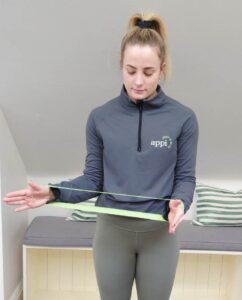Written By Lucy Metcalfe
MSK Physiotherapist, APPI Pilates Instructor
BScPhysio MCSP
How common is shoulder pain?
It’s common! Every year, 14.7 per 1000 people per year report shoulder pain, with a lifetime prevalence of up to 70%.
What are the different types of shoulder pain?
Most commonly as Physiotherapists, we see rotator cuff related shoulder pain (RCRSP). People come to us because they’re experiencing pain and restriction of shoulder movement and everyday function. People mainly have problems raising their arm forwards and/or rotating it outwards.
What can influence shoulder pain?
There are many things that influence shoulder pain including: genetics, hormones, lifestyle factors (smoking, alcohol), other injuries and medical conditions as well as psychological factors, such as stress. However, the largest influence has been linked to poorly controlled, excessive and repetitive loading of the shoulder tissues.
What is the anatomy of the shoulder?
The shoulder is classed as a ball and socket joint. The ball is formed by the top of the upper arm bone (called the humerus) and the socket is formed from the shoulder blade (technically called the scapula).
The rotator cuff muscles and tendons are designed to stabilise the ball within the socket during movement. The rotator cuff muscles include the supraspinatus, infraspinatus, teres minor and major and subscapularis.
In addition, to have a structurally sound shoulder, the shoulder’s deltoid muscle also acts to stabilise the ball onto the socket which in turn allows the rotator cuff muscles to rotate the shoulder with correct alignment and control.

When the shoulder becomes injured, we plan to rehabilitate the rotator cuff and deltoid muscles to ensure that the shoulder is structurally stable and moving in an optimal way.
What exercises can I do to build my shoulder strength?
By combining stretching and strengthening exercises into an individually tailored exercise program, Physiotherapy can significantly reduce the recovery time following surgery and greatly increase muscle strength and the range of motion of the affected rotator cuff. We recommend the following exercises to get you started at home. However, studies have shown that the specialised supervision of a trained Physiotherapist allows for a significantly better recovery after rotator cuff surgery.
- Mini-band shoulder flexion: x 10-12 repetitions x 2/3 sets
Put the band around your wrists with your elbows extended and arms by your side. Put a minimal amount of pressure into the band and rotate your thumbs 45° out. Maintaining the pressure, lift your arms all the way overhead. Do not extend your spine or thrust your chin forward.
Lower the arms to come back to the starting position and repeat.

- Mini-band shoulder external rotation x 10-12 repetitions x 2/3 sets
Stand, hold the ends of an elastic in your hands, tuck your elbows in by your sides, and bend your elbows at 90 degrees. Have no slack in the theraband.
Externally rotate one arm while the other side is working isometrically to resist any movement. The fixed arm must remain pointing straight forward without any movement. You can use a mirror to monitor the movement. Alternate sides.

- Banded latissimus dorsi pull down x 10-12 repetitions x 2/3 sets
Attach an elastic band above a closed door. Bring your shoulders back and down and hold the elastic strap.
Pull your arm backward while keeping your elbow straight. Return to the starting position.

- Banded face pulls x 10-12 repetitions x 2/3 sets
Hold the ends of a theraband anchored to an object located in front of you. With the palms facing down, pull the band toward your neck with the elbows high and the shoulders low. Keep your back straight and don’t poke the chin forward as you pull.

For more information on how Physiotherapy can effectively help your shoulder pain, please contact us and we’d be pleased to examine your shoulder, and develop a personalised treatment plan that specifically addresses your needs.

